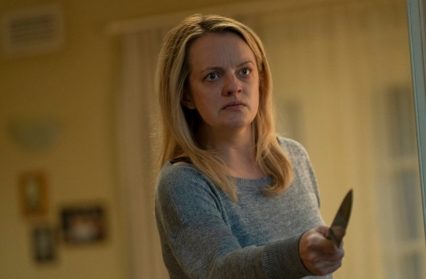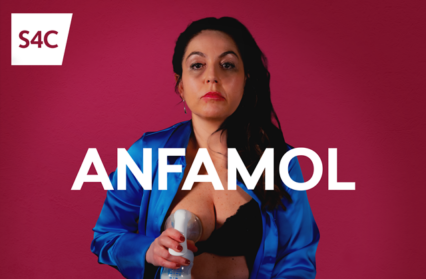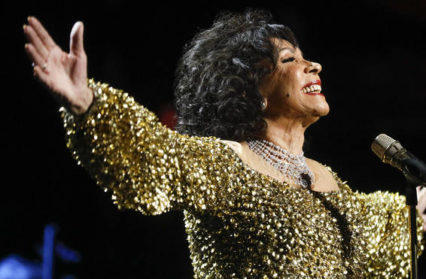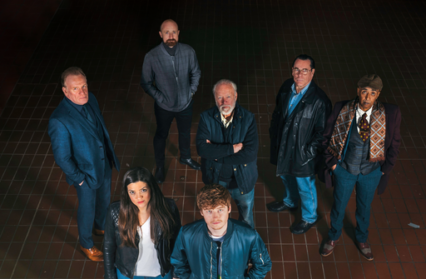Rosie Couch looks at the latest screen adaptation of H.G. Wells’s The Invisible Man and asks if its updated themes centring around domestic violence are addressed quite as potently as they might have been.
[This article contains spoilers]

Throughout the opening credits of The Invisible Man (2020), we are at sea. Waves rush, crashing against rocks, shooting upwards, curling back. The wind howls, thunder rumbles. It is chaos. As the camera pans up, taking in a steep cliff face, our gaze settles upon a house emitting an orange glow. A radiant beacon against the stormy tumult, it promises warmth, safety, protection. Or does it?
As a film highly concerned with looking and listening, it is fitting that the less you see and hear about The Invisible Man before sitting down to watch it, the more its twists and turns are likely to take effect. That being said, the premise of the film is far from brand new. As a retelling of the 1897 novel of the same name by H.G. Wells, the 2020 incarnation of The Invisible Man is drawing upon known tropes of horror and science fiction. Director Leigh Whannell’s efforts do not mark the novel’s first foray into film. In 1933, director James Whale adapted it for the screen. This first adaptation, also produced by Universal Pictures, followed a similar narrative trajectory to Wells’ text. A mysterious man – invisible, of course, beneath completely inconspicuous bandages and dark glasses – arrives at the English village of Iping, Sussex. In the novel and the 1933 adaptation, the invisible man, Griffin, has chemically devised a way to render his body invisible. To shortly summarise the narrative trajectory, after committing an assortment of crimes, including murder, the invisible man is, himself, killed. In death, he becomes visible once again. The 2020 adaptation marks a huge shift from these existing stories, both geographically – moving from Sussex, England to Stinson Beach, California – and thematically. This contemporary retelling of The Invisible Man is retold from the perspective of Cecilia Kass (Elisabeth Moss). At the outset of the film, we find Cecilia escaping from her husband: the rich and powerful Optics expert, and titular invisible man, Adrian Griffin (Oliver Jackson-Cohen). On hearing that Adrian has taken his own life, news that is later revealed to be fabricated, Cecilia believes that she is finally free from his controlling, abusive behaviour. Her relief is short-lived. Though she can no longer see Adrian, he is certainly still around. He refuses to let go.
If you’ve watched the trailer of The Invisible Man prior to watching the film, you will likely already have an inkling whilst watching the opening sequence that, actually, the house on the cliff is the opposite of a ‘port in a storm’. As we enter and see protagonist Cecilia in bed, an arm clasped around her waist, an air of uncertainty remains. Once she has temporarily removed herself from husband Adrian’s grip, she lightly pads around the house in socked feet. The contrast of danger and comfort continues further still as Cecilia treads amongst the soft glow of the interiors, enveloped as it is by shadowy nooks and corners. The opening scenes of the film, hinting at and then destabilising the sanctuary of the home, a glimpse at two enduring and salient themes.
The first is the grip that we hold, both cinematically and in lived experience, on the relationship between sight and knowledge. What we are – or, as is more often the case, are not – seeing is constantly called into question throughout the film. Where, conventionally, flashbacks would stylistically construct the violence previously enacted upon Cecilia and the restrictions on her autonomy, we lean heavily on her testimony. Visual cues, like the concrete fence that she scales during her escape or the in-home surveillance cameras that she manipulates, elude to such restrictions, but we do not see the history of domestic violence from which she is escaping. The second theme, linked to the first, involves a revision of the idea that the spheres of domesticity and heterosexual romance are inherently safe spaces for women. Again, the question of what is public and private, what is seen and unseen become highly pertinent. To exist as a woman in a patriarchal system is to live with the threat of violence, often intensified by intersections of gender, race, sexuality, class, and ability. Like that which Cecilia battles throughout The Invisible Man, the threat or existence of such violence can’t always be seen or proven, no matter how consistently it is felt.
Statistically, up to seventy per cent of women have experienced physical and/or sexual violence from a romantic partner in their lifetime, as opposed to an estimated thirty-five per cent experiencing the same from a non-partner. This knowledge, this threat, is insidious. It hovers, encroaches, sneaks into your existence. It’s there when you’re walking in the dark, keys clasped in your fist, crossing the road to avoid strangers. And, as The Invisible Man indicates and the aforementioned statistics corroborate, home is not the safe haven that it should be, either.
Though we do not see the realities of Cecilia’s life before her escape, we are still witnesses to the violence Adrian enacts on her, as the invisible man, after his staged suicide. It is this violence, I think, that fuels my ambivalent feelings about this film. On the one hand, as an exploration of domestic violence from a woman’s perspective, to see the effects of such violence in isolation to the acts themselves is undoubtedly visually potent. However, though Cecilia eventually triumphs over her abuser, does the visual absence of Adrian when committing such acts also have an adverse effect? If we are only able to see Cecilia being hurt, is the particularity of Adrian as an abuser lost from the situation? Or, does such a complex dynamic force us to look and think beyond what is immediately visible? At times, the long sequences of violence did, for me, tip over into prurience. Moss’s performance as protagonist Cecilia is nothing short of outstanding. With dexterity, she performs a character who is undoubtedly whittled down by the abuse to which she has been subjected, but who still contains the same core of ‘brute strength’ that she recognises in her sister Emily (Harriet Dyer).
Nonetheless, the scenes in which she is thrown around the room like a ragdoll are uncomfortably and needlessly drawn out. Perhaps the gratuitous intensity of these scenes can be attributed to Whannell’sbackground in strikingly different modes of horror, with involvement in writing, directing, and producing films belonging to the Saw (2004-6) and Insidious (2010-18) franchises. Maybe these films – including, respectively, unrelenting gore on the one hand, and red-faced demons with lengthy talons on the other – do not provide the most ideal background of experience when aiming to sensitively handle and portray violence against women on-screen.
Speculation aside, the film’s strengths lie during its quieter moments. In the utter dread as we follow Cecilia’s gaze to an apparently vacant corner, or the familiar darkness of a night-time doorway. In the wide camera shot as it mimics the movements of surveillance capture, following Cecilia as she leaves the kitchen; looping back as, almost imperceptibly, the flames on the stove suddenly surge to full power. During these moments, to watch The Invisible Man is to be held in expectation, always waiting for something sinister at the edge of your periphery. And it is these moments, these images, that endure. They offer possibilities for representing, as I mentioned before, the lingering threat of violence, but also how trauma might return and repeat on lived experience. Similarly, in relation to feminine spectatorship and cinematic pleasure, such scenes prompt intriguing questions: When, in relation to cinema, discussions around looking are inextricably bound up with notions of desiring, what does it mean to look at ‘nothing’?
Despite the ambivalent feelings that I have about The Invisible Man, it does relate to an overwhelmingly timely message. Listen to women when they talk about their experiences of violence. Trust their testimonies. It is perhaps trite and certainly predictable to discuss this film in relation to #MeToo but, writing this article less than a week after Harvey Weinstein’s sentencing for acts of rape and sexual assault, how can I not? Given the crucial role of women’s testimonies in bringing him to justice, it is suitable, I suggest, to draw such a parallel. The opinion is divided on whether initial sentencing of twenty-three years can sufficiently be marked as justice, or progress for the movement as a whole. On the one hand, and quite understandably given historical and contemporary precedent, many thought that Weinstein would not be convicted at all. On the other, he is only one man in an industry propped up by predators and inequality. The sentence he has currently received only accounts for two out of five charges. The scale of accusations levelled against him and other men within the industry, beyond the women who have bravely testified, is a clear indication that we are still very much at the beginning of what is, hopefully, a shift away from male hegemonic violence.
The Invisible Man illustrates the potential of film as a potently suggestive vehicle for enacting this important work. Though films such as Bombshell (2019) arguably encapsulated a certain zeitgeist of the #MeToo milieu, it is difficult to ignore its focus on a certain, normative model of white femininity. When #MeToo was started by a black woman named Tarana Burke in 2006 but was subsequently co-opted by white feminism, such attempts at critical film-making – if that is, in fact, what Bombshell aspires to be – seem to miss the point. As I have suggested, Moss’s performance in The Invisible Man is excellent. Similarly, however, the exploration of violence in this film is restricted to a model of white, upper-middle-class femininity. Whilst discussions about the extent of all kinds of violence against women are crucial and important work, such a narrow cinematic focus barely skims the surface. Horror is, ultimately, about otherness, how boundaries might be crossed, and how what is considered to be ‘normal’ might be unsettled. The recently announced adaptation of Dracula with Karyn Kusama as director – known for Jennifer’s Body (2009) and The Invitation (2015) – is a hopeful sign for a new wave of horror that seeks to address those aforementioned themes. Despite its issues, The Invisible Man is, undoubtedly, a fresh new take on an existing narrative. Perhaps Dracula, and, more speculatively, subsequent classic horror adaptations will continue to redeploy known tropes and patterns in order to explore intersections of identity and unsettle boundaries. We will have to wait and see.
To find out more about the latest screen adaption of The Invisible Man by H.G. Wells, click here.
Rosie Couch is co-chair and editor of Assuming Gender and is a regular contributor to Wales Arts Review.



 Enjoyed this article? Support our writers directly by buying them a coffee and clicking this link.
Enjoyed this article? Support our writers directly by buying them a coffee and clicking this link.








